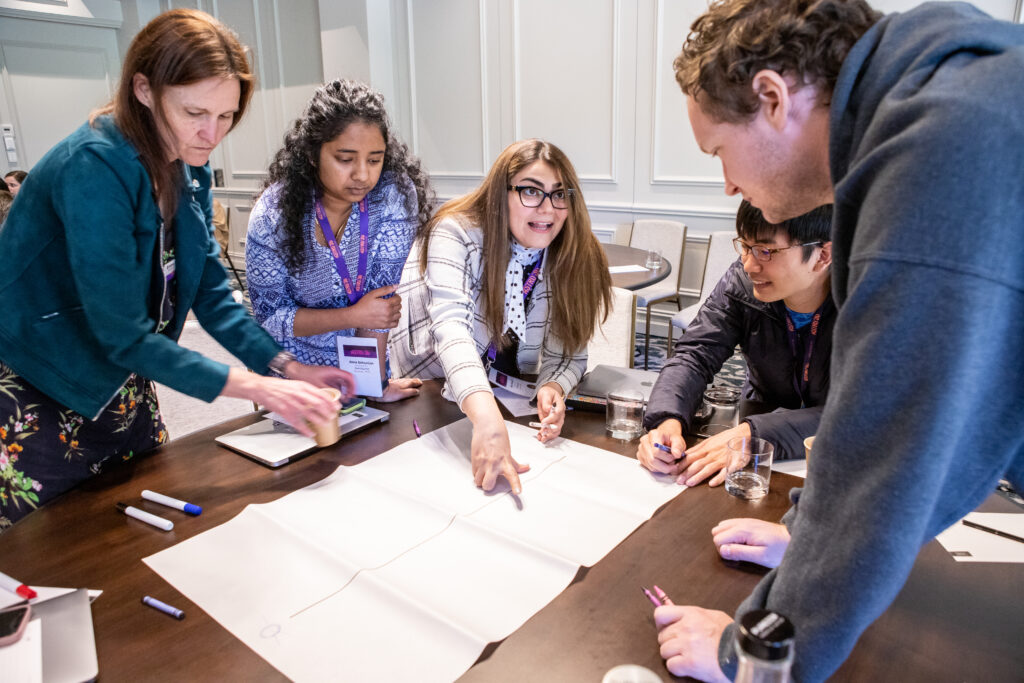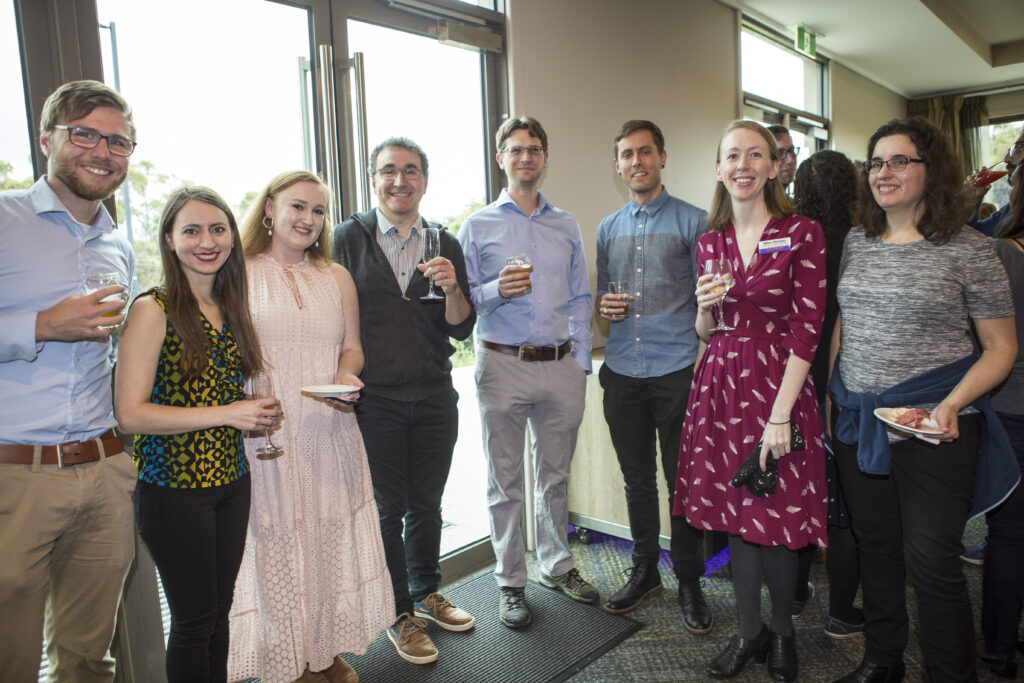… all while discovering how the Universe evolved, how galaxies form and where the elements come from.

ASTRO 3D members at our December 2022 meeting (credit: Cristy Roberts)
Around the world, research agencies are struggling to achieve gender parity.
A paper published in Nature Astronomy today reports how a national Australian astronomy centre achieved equal numbers of women and men using science.
“We used research in sociology and psychology to develop evidence-based strategies, and to create a supportive and positive culture in our Centre,” says Professor Lisa Kewley, the founding director of ASTRO 3D, the Australian Research Council Centre for All Sky Astrophysics in 3 Dimensions, and the lead author on the paper. Professor Kewley now leads the Center for Astrophysics, Harvard & Smithsonian.
“Our success offers a model to other organisations, especially in the physical sciences where participation rates for women continue to be well behind the biological sciences, and where gender equality has remained stubbornly low,” says Professor Emma Ryan-Weber, the current Director of ASTRO 3D.
“Astronomy is a gateway science,” says Professor Ryan-Weber. “Students are fascinated by the question of what’s out there in space and how the elements that fused inside stars end up being the oxygen we breathe. I am proud that our centre is providing a diverse range of role models for the next generation – encouraging them to take up maths and physics, which opens up career opportunities not just in astronomy but across the physical sciences and a range of technical industries, such as data science.”

Emma Ryan-Weber, Alma Sebastian, Hasti Nateghi, Takafumi Tsukui, Adam Stevens (credit: Cristy Roberts)
“Astronomy is regarded as leading in gender equity in the physical sciences. But when we established ASTRO 3D in 2017, I looked at the numbers and realised that on current trends it would take more than 60 years to reach gender parity,” says Professor Kewley.
Across Australia, women make up 30 to 35% of PhD astronomy students, and less than 20% at the highest professorial level. “And women are more than three times more likely to leave the profession. Sixty-two per cent of women and 17% of men leave astronomy at the junior postdoctoral levels. We had to do better,” Professor Kewley says.
“Our program was implemented between December 2017 and January 2023. In that time, ASTRO 3D went from 38% women to 50%,” she says.
The key steps included:
- setting diversity targets with regular monitoring of progress
- selecting a diverse set of team leaders
- in-person diversity training for all organisation members
- ensuring 50% women on postdoctoral selection committees
- ensuring 50% women on postdoctoral short-lists.
“Diverse leadership is crucial for improving the diversity within teams,” says Professor Stuart Wyithe, Director of the Research School for Astronomy & Astrophysics, The Australian National University.
“Women-led teams recruited and retained more women postdoctoral researchers, attracted more women students, and worked with more women collaborators, while the converse was true for men-led teams,” he says.

Diverse leadership leads to diverse membership: Sven Buder, Kathryn Grasha, Grace Lawrence, Luca Cortese, Thomas Nordlander, Rob Bassett , Nikki Neilsen, Barbara Catinella (credit: Cristy Roberts)
“The ASTRO 3D program reached a tipping point when there were 40% women in the organisation as supervisors, mentors and role models for students. After that, student enrolments by women in the Centre accelerated. The gains were not made at the expense of men, as the membership grew over this period,” Professor Kewley says.
Recruiting women is one thing, but retaining them is just as important and ASTRO 3D introduced a range of policies to make sure their staff felt welcome and valued. These included a focus on leadership development, promotion of work-life balance, partner recruitment, as well as pathways for reporting misconduct.
In all categories, larger percentages of women were retained than men.
Among students, 55 to 58% women were retained compared with 37 to 48% men and a larger percentage of women postdoctoral researchers were retained in the Centre (67 to 70% women and 55 to 69% men).
“This suggests that the presence of women supervisors and role models is critical for attracting and retaining women.”
Professor Ryan-Weber , who is also an astronomer at Swinburne University of Technology, says the paper clearly paves the way for other research centres to achieve similar results.
“Our researchers have made phenomenal discoveries in understanding how elements, stars, galaxies and the gas that surrounds them evolved from the early Universe to today. Their skills have translated to international success in academia and to solve real-world problems in industry.
“But the greatest legacy of ASTRO 3D may be as a role model for better diversity in research,” she says.
For more information and to coordinate interview with study authors
For ASTRO 3D: Tom Carruthers, tom@scienceinpublic.com.au,
+61 404 404 026
For Harvard & Smithsonian: pubaffairs@cfa.harvard.edu
Read on for the abstract and third-party comments.
Published paper available upon request.
Supplementary information includes supporting quotes, background context on Women in STEM, and achievements of ASTRO 3D.
Download:
Supporting Information
Additional and third-party reactions/comments
Dr Kim-Vy Tran (co-author) Centre for Astrophysics, Harvard & Smithsonian
Role models really do matter. By supporting individuals at all levels in ASTRO 3D, young astronomers know they can be it because they can see it.
Ingrid McCarthy (co-author) Chief Operating Officer, ASTRO 3D
It’s been a huge achievement for the Centre to achieve gender parity. As COO, being able to develop and implement best-practice guidelines, policies, and procedures has been a rewarding endeavour. To see the Gender Equity program achieve its goals and have 50:50 gender as a standard in physical science research organisation has been a highlight of my career so far. I look forward to sharing what we’ve achieved at ASTRO 3D with other Centres of Excellence and research organisations.
Professor Lisa Harvey Smith Australia’s Women in STEM Ambassador
I applaud Professor Kewley and colleagues on implementing evidence-based changes to workplace policies and practices that have clearly made a positive impact. It just goes to show how quickly progress can be made when workplace change initiatives are properly designed, monitored, and evaluated. I hope the directors of other research institutes take note.
Note: The gender parity program has been submitted to the Office of the Women in STEM Ambassador’s STEM Equity Evaluation Portal to further facilitate research centres in replicating these results.
Professor Orsola De Marco Chair, Australian Astronomy Limited; Professor of Physics, Astrophysics and Space Technologies Research Centre, Macquarie University
The ARC Centre of Excellence for All Sky Astrophysics in Three Dimensions (ASTRO 3D) is a microcosm of the astronomical scientific community. They have demonstrated convincingly that relatively simple methodologies can lead to gender parity over a short time. Additional longitudinal studies will allow us to determine what other methods can retain gender parity into later career stages. Gender parity in all the sciences will allow us to access talent from the entire population, not just half of it. It maximises the number of brilliant brains working to solve our most difficult and existential problems.
A/Professor Stas Shabala President, Astronomical Society of Australia
One of the outstanding achievements of ASTRO 3D is the high retention rate of early career researchers, especially women. Early career scientists often lack long-term job security at a time when they are also making major life decisions. It is sobering to reflect that one in three STEM-qualified women in Australia are not in the STEM workforce several years after having children — suggesting that they have traditionally not been supported in their careers. ASTRO 3D shows how this can be done better. We need more initiatives like this nationally to address the looming shortage of STEM-skilled professionals, and drive Australia’s knowledge economy.
Professor Virginia Kilborn Chair, National Committee for Astronomy
I’m thrilled to see the ASTRO 3D outcome of gender parity within 5 years in the traditionally male-dominated field or astronomy. This shows the effectiveness of bold targets coupled with evidence-based methodologies and actions. ASTRO 3D’s success provides a road map for other groups, centres and disciplines in gender disparate fields to make a real and lasting difference.
About ASTRO 3D
The ARC Centre of Excellence for All Sky Astrophysics in 3 Dimensions (ASTRO 3D) is a $40 million Research Centre of Excellence funded by the Australian Research Council (ARC) and nine collaborating Australian universities: The Australian National University, The University of Sydney, The University of Melbourne, Swinburne University of Technology, The University of Western Australia, Curtin University, Macquarie University, The University of New South Wales, and Monash University.
Paper details
Journal: Nature Astronomy: https://www.nature.com/articles/s41550-023-02079-6
https://doi.org/10.1038/s41550-023-02079-6
The achievement of gender parity in a large astrophysics research centre
Lisa J Kewley1,2,3, J. Stuart B. Wyithe1,2,4, Kim-Vy Tran2,3, Ingrid McCarthy1,2
1 Research School for Astronomy
& Astrophysics, Australian National University,
Canberra, Australian Capital Territory, Australia
2 ARC Centre of Excellence for All Sky Astrophysics in
3 Dimensions (ASTRO 3D), Canberra, Australian Capital
Territory, Australia
3 Centre for Astrophysics, Harvard & Smithsonian,
Cambridge, MA, USA
4 University of Melbourne, Parkville, Victoria,
Australia
ABSTRACT
In Australian astronomy, women’s representation remains at historic lows, despite a decade of initiatives aimed at improving the representation and support of women in astronomy and academia more generally. Drawing from research in the fields of sociology and psychology, we designed a new evidence-based programme to increase the percentage of women recruited and retained in astronomy. We applied identical recruitment methods to 47 fixed-term postdoctoral positions across nine universities from 2017 to 2022 within the ARC Centre of Excellence for All Sky Astrophysics in 3 Dimensions (ASTRO 3D). Through this method, ASTRO 3D achieved 50% women personnel in five years, including 56% women postdocs and 52% women students recruited. A tipping point was reached at 40% women overall, after which women students enrolled in the centre in accelerating numbers. Evidence-based retention initiatives were highly successful, yielding greater retention of women than men. The percentage of women in teams correlated strongly with the team lead gender, highlighting the importance of diverse team leadership. This work presents a clear pathway for organizations to achieve and retain gender diversity within postdoctoral and student cohorts without quotas.
Fantastic achievement. Congratulations to all involved.